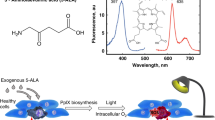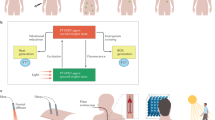Abstract
An in vivo study of tissue distribution kinetics and photodynamic therapy (PDT) using 5-aminolaevulinic acid (ALA), chlorin e6 (Chl) and Photofrin (PII) was performed to evaluate the selectivity of porphyrin accumulation and tissue damage effects in a tumour model compared with normal tissue. C26 colon carcinoma of mice transplanted to the foot was used as a model for selectivity assessment. Fluorescence measurements of porphyrin accumulation in the foot bearing the tumour and in the normal foot were performed by the laser-induced fluorescence (LIF) system. A new high-intensity pulsed light delivery system (HIPLS) was used for simultaneous irradiation of both feet by light in the range of 600-800 nm, with light doses from 120 to 300 J cm-2 (0.6 J cm-2 per pulse, 1 Hz). Photoirradiation was carried out 1 h after injection of ALA, 3 h after injection of Chl and 24 h after injection of PII. A ratio of porphyrin accumulation in tumour vs normal tissue was used as an index of accumulation selectivity for each agent. PDT selectivity was determined from the regression analysis of normal and tumour tissue responses to PDT as a function of the applied light dose. A normal tissue damage index was defined at various values (50, 80 and 100%) of antitumour effect. The results of the LIF measurements revealed different patterns of fluorescence intensity in tumour and normal tissues for ALA-induced protoporphyrin IX (ALA-PpIX), Chl and PII. The results of PDT demonstrated the differences in both anti-tumour efficiency and normal tissue damage for the agents used. The selectivity of porphyrin accumulation in the tumour at the time of photoirradiation, as obtained by the LIF measurements, was in the order ALA-PpIX > Chl > PII. PDT selectivity at an equal value of anti-tumour effect was in the order Chl > ALA-PpIX > PII. Histological examination revealed certain differences in structural changes of normal skin after PDT with the agents tested. The results of PDT selectivity assessment with respect to differences in mechanisms of action for ALA, Chl and PII are discussed.
This is a preview of subscription content, access via your institution
Access options
Subscribe to this journal
Receive 24 print issues and online access
$259.00 per year
only $10.79 per issue
Buy this article
- Purchase on Springer Link
- Instant access to full article PDF
Prices may be subject to local taxes which are calculated during checkout
Similar content being viewed by others
Author information
Authors and Affiliations
Rights and permissions
About this article
Cite this article
Orenstein, A., Kostenich, G., Roitman, L. et al. A comparative study of tissue distribution and photodynamic therapy selectivity of chlorin e6, Photofrin II and ALA-induced protoporphyrin IX in a colon carcinoma model. Br J Cancer 73, 937–944 (1996). https://doi.org/10.1038/bjc.1996.185
Issue Date:
DOI: https://doi.org/10.1038/bjc.1996.185
This article is cited by
-
Bionic natural small molecule co-assemblies towards targeted and synergistic Chemo/PDT/CDT
Biomaterials Research (2023)
-
Enhanced photodynamic efficacy and efficient delivery of Rose Bengal using nanostructured poly(amidoamine) dendrimers: potential application in photodynamic therapy of cancer
Cancer Nanotechnology (2011)
-
Simulation of fractionated and continuous irradiation in photodynamic therapy: study the differences between photobleaching and singlet oxygen dose deposition
Australasian Physical & Engineering Sciences in Medicine (2011)
-
Enhancement of methyl-aminolevulinate photodynamic therapy by iron chelation with CP94: an in vitro investigation and clinical dose-escalating safety study for the treatment of nodular basal cell carcinoma
Journal of Cancer Research and Clinical Oncology (2008)
-
Photodynamic therapy for cancer
Nature Reviews Cancer (2003)



